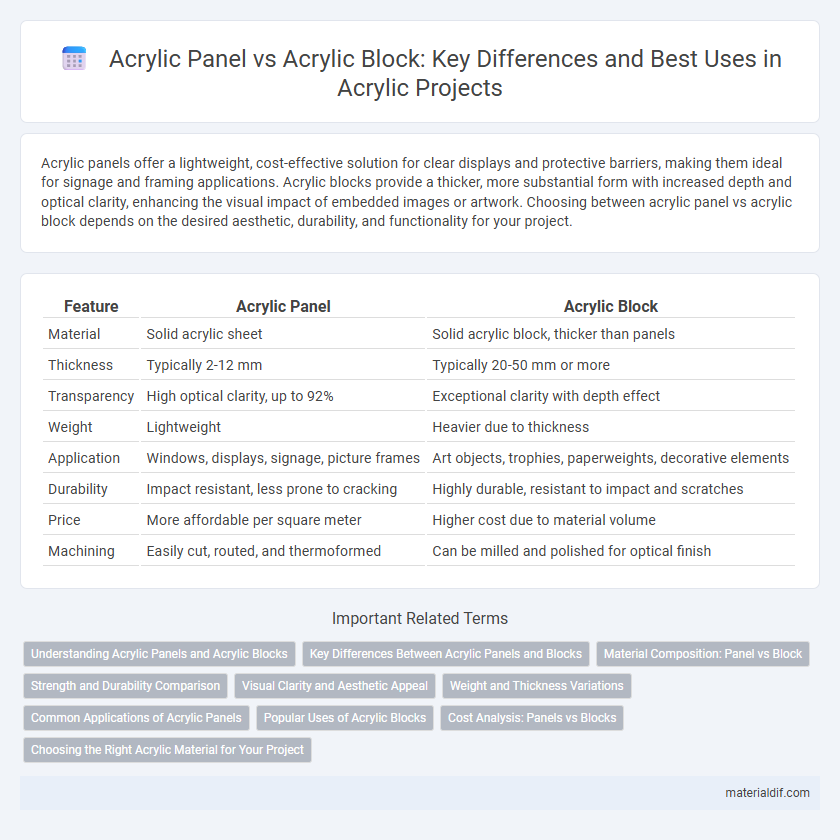Acrylic panels offer a lightweight, cost-effective solution for clear displays and protective barriers, making them ideal for signage and framing applications. Acrylic blocks provide a thicker, more substantial form with increased depth and optical clarity, enhancing the visual impact of embedded images or artwork. Choosing between acrylic panel vs acrylic block depends on the desired aesthetic, durability, and functionality for your project.
Table of Comparison
| Feature | Acrylic Panel | Acrylic Block |
|---|---|---|
| Material | Solid acrylic sheet | Solid acrylic block, thicker than panels |
| Thickness | Typically 2-12 mm | Typically 20-50 mm or more |
| Transparency | High optical clarity, up to 92% | Exceptional clarity with depth effect |
| Weight | Lightweight | Heavier due to thickness |
| Application | Windows, displays, signage, picture frames | Art objects, trophies, paperweights, decorative elements |
| Durability | Impact resistant, less prone to cracking | Highly durable, resistant to impact and scratches |
| Price | More affordable per square meter | Higher cost due to material volume |
| Machining | Easily cut, routed, and thermoformed | Can be milled and polished for optical finish |
Understanding Acrylic Panels and Acrylic Blocks
Acrylic panels are flat, lightweight sheets commonly used for glazing, signage, and protective barriers due to their clarity and impact resistance. Acrylic blocks differ by their solid, thick form, often used in art display and decoration, offering enhanced depth and optical clarity without the need for framing. Understanding these differences helps in selecting the appropriate acrylic material for construction, design, or artistic applications.
Key Differences Between Acrylic Panels and Blocks
Acrylic panels are thin, flat sheets designed for applications like glazing, signage, and displays, offering flexibility in size and easy cutting or drilling. Acrylic blocks are thicker, solid pieces ideal for optical clarity and creating three-dimensional effects in photo displays or awards due to their depth and light refraction properties. Key differences include thickness, with panels typically ranging from 1mm to 10mm, while blocks measure several centimeters, and intended use, where panels prioritize coverage and versatility, whereas blocks emphasize durability and visual depth.
Material Composition: Panel vs Block
Acrylic panels are fabricated from cast or extruded polymethyl methacrylate (PMMA) sheets, resulting in flat, uniform surfaces ideal for glazing and display applications. Acrylic blocks, composed of solid PMMA resin poured into molds, feature substantial thickness and optical clarity, often used for artistic and decorative purposes. The material composition difference affects durability, light transmission, and fabrication techniques, with panels being lighter and easier to cut, while blocks offer enhanced depth and visual impact.
Strength and Durability Comparison
Acrylic blocks exhibit superior strength and durability compared to acrylic panels due to their solid, thicker construction, making them resistant to impact and daily wear. Acrylic panels, while still strong, are more prone to scratches and cracks under heavy stress because of their thinner, flat form. The enhanced density and dimensional stability of acrylic blocks provide longer-lasting performance in demanding applications.
Visual Clarity and Aesthetic Appeal
Acrylic panels offer superior clarity with a smooth, flat surface that enhances visual transparency, making them ideal for displays and signage requiring sharp image reproduction. Acrylic blocks feature a thick, crystal-like structure that magnifies and distorts light, creating a three-dimensional effect with enhanced depth and aesthetic appeal. The choice between the two depends on whether the priority is flawless transparency or a striking, sculptural visual impact.
Weight and Thickness Variations
Acrylic panels typically offer a wider range of thickness options, from 1mm to 25mm, making them suitable for lightweight applications requiring flexibility in design. Acrylic blocks, on the other hand, are generally thicker and heavier, ranging from 20mm to 50mm or more, providing enhanced durability and a solid, substantial feel. Weight differences arise because thicker acrylic blocks have increased density and volume, while panels balance between strength and reduced weight for ease of installation.
Common Applications of Acrylic Panels
Acrylic panels are widely used in signage, display cases, and protective barriers due to their clarity, lightweight nature, and ease of fabrication. These panels serve as ideal materials for retail displays, window glazing, and interior partitions, offering high impact resistance and UV protection. Compared to acrylic blocks, panels provide greater versatility in size and thickness, making them suitable for custom installations and architectural applications.
Popular Uses of Acrylic Blocks
Acrylic blocks are widely favored in interior design and retail displays due to their thick, solid form, which provides a polished and modern aesthetic. Common uses include photo keepsakes, promotional signage, and awards, where clarity and durability highlight the visuals inside the block. These blocks offer a three-dimensional effect that enhances image depth and color vibrancy, distinguishing them from thinner acrylic panels.
Cost Analysis: Panels vs Blocks
Acrylic panels generally offer a more cost-effective solution compared to acrylic blocks due to lower material and manufacturing expenses. While acrylic blocks provide enhanced durability and a premium aesthetic with thicker dimensions, their production involves higher raw material costs and complex molding processes. For budget-sensitive projects requiring large surface coverage, acrylic panels deliver optimal value without compromising clarity and strength.
Choosing the Right Acrylic Material for Your Project
Acrylic panels offer a versatile, lightweight solution ideal for large surface applications such as windows, signage, or protective barriers due to their ease of cutting and shaping. Acrylic blocks provide a thicker, solid form factor that enhances depth and clarity, making them perfect for artistic displays, awards, or projects requiring a robust, three-dimensional aesthetic. Selecting between acrylic panel and block depends on the project's demand for thickness, clarity, and structural strength.
Acrylic Panel vs Acrylic Block Infographic

 materialdif.com
materialdif.com